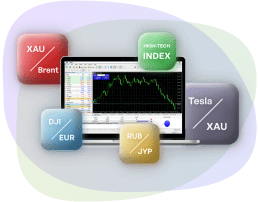- Education
- Forex Trading Strategies
- Strategies by Forex Analysis
- Technical Analysis Strategy
- Multiple Time Frame Analysis Strategy
Multiple Time Frame Analysis Strategy
KEY TAKEAWAYS
- Multiple time-frame analysis involves monitoring the same currency pair across different frequencies.
- Each time frame has its benefits.
- The methodology behind using multiple time frames is that traders can start to build a clearer picture of the price action and technical analysis story.
Multiple Time Frame Trading Strategy
Traders often use Forex patterns as a Forex strategy.
The multiple time frames trading strategy is a Forex trading strategy that works by following a single currency pair over different time frames. By following the price chart traders can see the highs and lows and establish the overall and temporary trend. However, when looking at the different time frames traders can see changes and patterns that they were not able to spot by using a single time frame.
Each time frame has its benefits. Long time frames allow traders to understand the bigger picture and identify the overall trend. Average time frames present the short term trend and show traders what is happening in the market right now. Short time frames are traders' way of recognizing the exact window for when to make their move.
Multiple Time Frame Analysis
Multiple time-frame analysis involves monitoring the same currency pair across different frequencies. There is no real limit on how many frequencies can be monitored, but there are general guidelines that most traders practice. So, generally traders use three different periods; enough to have a read on the market. If used more it might result in redundant information and if less could be not enough data.
It's important to choose the right time frames when selecting the range of three periods, for example, if a long-term trader who holds the position for months decides to pick a 15, 60 minute time frame combination it will probably tell nothing to the trader.
Long-Term Time Frame - When using this method of studying the charts, it is best done with a long-term time frame and work down to the more certain frequencies. When a trader starts with a long-term time frame, he/she will be able to establish a general and dominant trend.
In foreign exchange markets, where long-term time frames are daily, weekly or monthly, fundamental factors have a significant impact on the direction of movement. That's why traders should monitor the major economic trends when following the general trend on this time frame to better understand the direction in price action. Such dynamics, though, tend to change infrequently, so traders will only need to check those occasionally.
Another thing traders should look out for is the interest rate. This is a reflection of the health of the economy. In most cases, capital will flow towards the higher rate currency in the pair, as this equates to a higher return on investment.
Medium-Term Time Frame - most versatile of the three frequencies because it is at this level that traders can get an idea of the short and long term time frames. This level should be the most frequently followed chart when planning a trade while the trade is on and as the position nears either its profit target or stop loss.
Short-Term Time Frame - trades should be made on a short-term timeframe. As the smaller swings in the price action become clearer, the trader will be able to choose the best entry for a position already determined by the higher frequency charts.
In short-term time frames fundamentals play a role as well, but in a different way than they do for the higher time frame. The more detailed this lower time frame is, the stronger the reaction to economic indicators will seem. These jerky movements are often very short-lived and are therefore sometimes described as noise. However, the traders often avoid making these trades.
Trading Multiple Time Frames
When all three time frames are combined and analyzed properly in the correct order, it will increase the chances of success. Performing this three-tiered in-depth analysis encourages big trend trading. This alone reduces risk, as there is a higher likelihood that price action will eventually continue in the direction of a longer trend. Applying this theory, the level of confidence in a trade should be measured by how the time frame coincides.
For example, if the larger trend is uptrend (sorry for redundancy) but the medium- and short-term trends are heading lower, shorts should be taken with reasonable profit targets and stops. A trader should probably wait until a bearish wave runs out on the lower frequency charts and look to go long at a good level when the three time frames line up once again.
Using multiple time frames while analyzing trades it helps to identify support and resistance lines which in turn helps to find a strong entry and exit levels.

Multiple Time Frame Trading Methodology
Multiple Time Frame Trading Methodology is straightforward, traders only need to focus on three steps:
- Look at price action and structure: highs and lows, basically finding the trend.
- Draw Fibonacci retracement levels between highs and lows to find support and resistance levels.
- Enter trades in the direction of the trend at support and resistance when you get a buy or sell signal.
The methodology behind using multiple time frames is that traders can start to build a clearer picture of the price action and technical analysis story:
- First have to look at the long-term time frame, to establish the dominant trend
- Then increase the granularity of the same chart to the intermediate time frame: smaller moves within the broader trend become visible
- And at last, execute trades on the short-term time frame.
Bottom line on Multiple Time Frame Trading Strategy
Using multiple time-frame analysis can be instrumental in making a successful trade. From this article you should be able to take how important multiple time-frame analysis can be. It is a simple way to ensure that a position benefits from the direction of the underlying trend.





